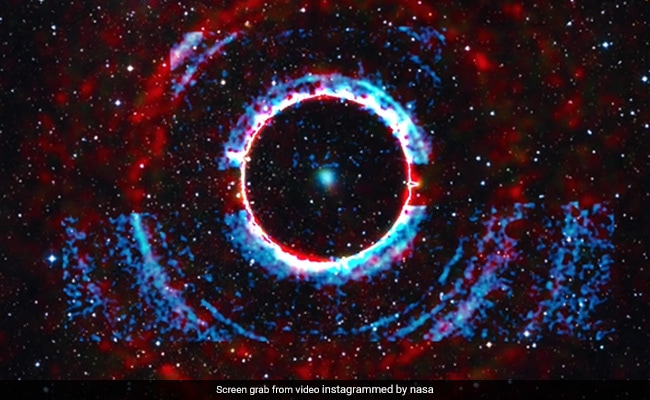
The “echoes of light” from the black hole have been converted into sound by the US space agency.
The mysteries of the black hole still baffle us despite the intense exploration of space. In a new video, NASA has attempted to explain the wonders of the spooky phenomenon. On Friday, the US space agency converted “light echoes” from a black hole into sound.
The space agency took to Instagram to share the video. “Black holes are notorious for not letting light (such as radio, visible rays, and X-rays) escape from them. However, the surrounding material can produce powerful bursts of electromagnetic radiation. As they travel outward, these light sculptures can bounce off clouds of gas and dust in space, Like how beams of light from a car’s headlights will scatter out of the fog,” they wrote in the caption.
In the video, the red circular bars are surrounded by a starry background. The blue bands highlight the inner and lower parts of the black hole system. “During the sonication process, the cursor moves outward from the center of the image in a circle. As it passes through echoes of light detected in the X-rays (seen as concentric rings in blue by Chandra and red by Swift in the image), tick-like sounds and changes in size to denote x-ray detection and differences in brightness,” the caption further explains.
Watch the video here:
According to NASA, the black hole in the video is about 7,800 light-years away from Earth. The black hole is between five and 10 times the mass of the Sun, and it is pulling material from a companion star into orbit around it, which is “directed into a disk surrounding the stellar-mass black hole,” according to the researchers. . V404 Cygni is a black hole-containing system. New sonication turns “light echoes” from the V404 Cygni black hole into sound.
Read also: Russian astronauts on a spacewalk outside the space station orbiting over Brazil
“NASA’s Chandra X-ray Observatory and the Neil Gehrels Swift Observatory have imaged X-ray light echoes around V404 Cygni,” the US space agency said. Astronomers can calculate when these outbursts occur because they know how fast light travels and have determined a precise distance to this system. This data, along with other information, helps astronomers learn more about dust clouds, such as their composition and distances.
Featured video of the day
Watch Arvind Kejriwal Town Hall: “Give me CBI for a day…”




More Stories
Boeing May Not Be Able to Operate Starliner Before Space Station Is Destroyed
Prehistoric sea cow eaten by crocodile and shark, fossils say
UNC student to become youngest woman to cross space on Blue Origin